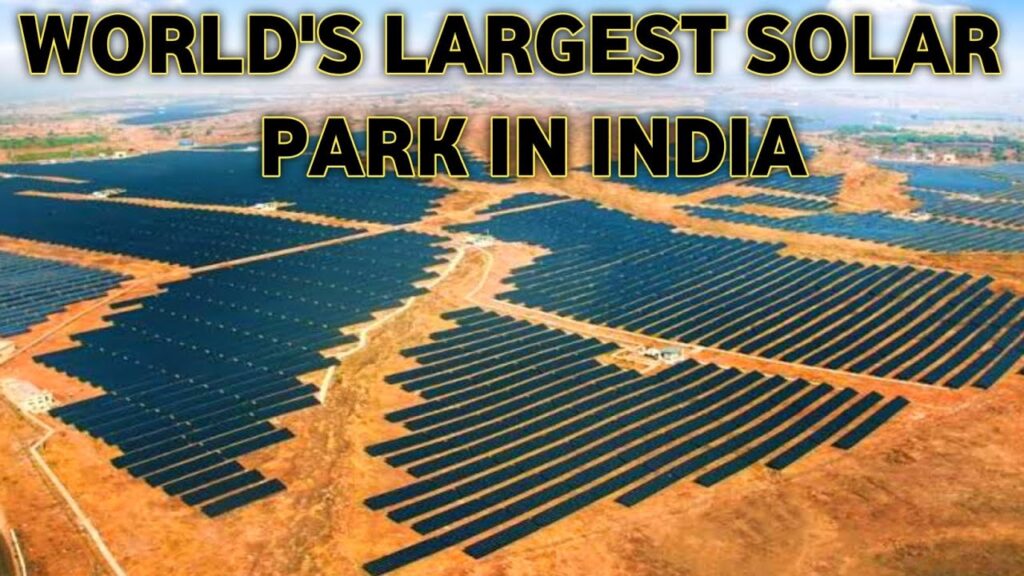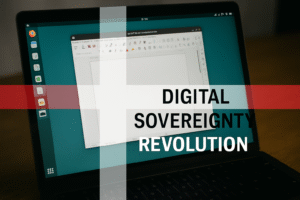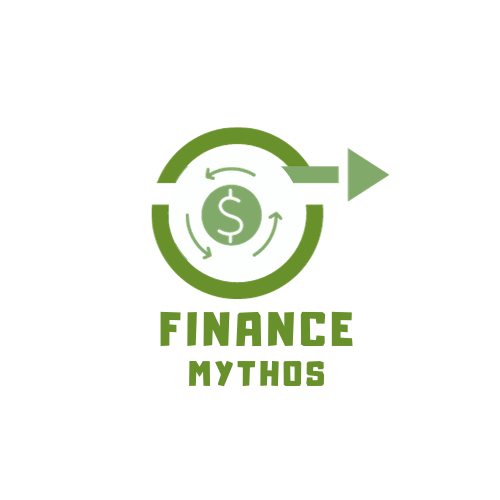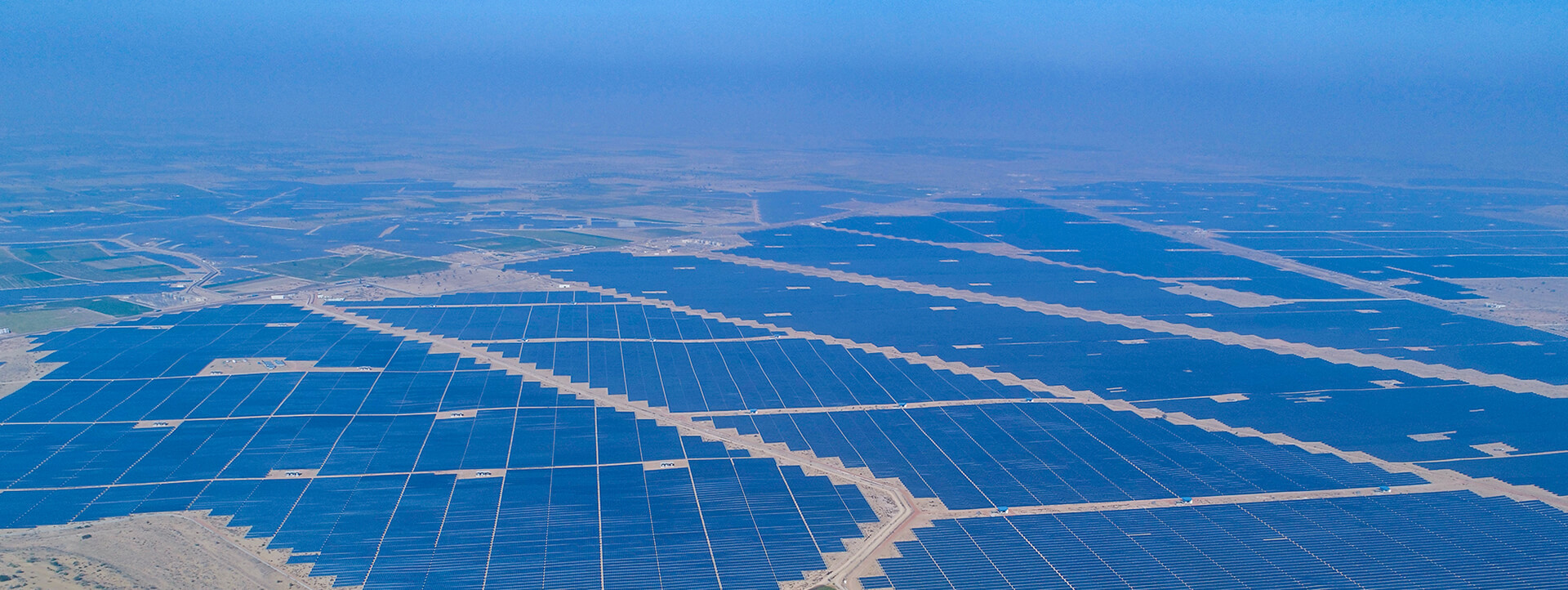In the heart of Rajasthan’s Jodhpur district lies the village of Bhadla, a place known for its scorching temperatures and severe sandstorms. But amidst the arid landscape, a transformative marvel has emerged – the Bhadla Solar Park. Spanning a staggering 14,000 acres, this solar park stands as a testament to the immense potential of harnessing solar energy on a grand scale.
Table of Contents
ToggleHarnessing the Sun's Power: The Rise of Bhadla Solar Park

With temperatures soaring to 46°C to 48°C during summers, Bhadla seemed an unlikely candidate for such a monumental project. Yet, with technological innovation and determination, it now hosts the world’s largest solar park, boasting a capacity of 2,245 MW. This single entity has the capability to power a city the size of Kolkata, exemplifying the profound impact solar energy can have on meeting global electricity demands.
Development of Bhadla Solar Park | Who made Bhadla solar park?
Where is Bhadla solar park located?
The Bhadla Solar Park, located in the Thar Desert of Rajasthan, Bhadla village, situated in the Jodhpur district of Rajasthan, India. It’s approximately 220 kilometres away from Jodhpur city on the Bap-Bhadla Road. It covers a vast area of 56 square kilometres and boasts a total installed capacity of 2,245 megawatts (MW), making it the largest solar park in the world as of 2023.
It’s part of India’s National Solar Mission, aiming to install 100 gigawatts (GW) of solar power by 2022.
This massive undertaking was developed in four distinct phases, each contributing to its impressive scale.
Phase I (75 MW)
- Developed by: Rajasthan Solar Park Development Company Limited (RSPDCL)
- Commissioned: October 2018
- Description: This initial phase comprised seven solar power plants, marking the beginning of the Bhadla project.
Phase II (680 MW)
- Developed by: RSPDCL
- Completed: April 2019
- Description: The second phase saw the addition of ten solar power plants, significantly increasing the park’s capacity.
Phase III (1,000 MW)
- Developed by: Saurya Urja Company of Rajasthan (joint venture between the government of Rajasthan and IL&FS Energy Development Company)
- Started: March 2020
- Description: This extensive phase involved ten solar power plants, further solidifying Bhadla’s position as a leading solar energy producer.
Phase IV (500 MW)
- Developed by: Adani Renewable Energy Park Rajasthan Ltd (AREPRL) (joint venture between the government of Rajasthan and Adani Enterprises)
- Completed: Late in 2020
- Description: The final phase consisted of ten solar power plants, bringing the total capacity of the Bhadla Solar Park to its current staggering level.
The Bhadla Solar Park exemplifies India’s commitment to renewable energy and its fight against climate change. Its remarkable story of phased development serves as an inspiration for other countries seeking to adopt sustainable energy solutions.
The Potential of Solar Energy: Scaling Up for Global Impact
The success of Bhadla Solar Park raises compelling questions about the scalability and viability of large-scale solar projects. Could entire deserts, such as the Sahara, be blanketed with solar panels to meet global energy needs? The answer lies in the staggering abundance of solar energy reaching our planet. At any given moment, approximately 173,000 terawatts of solar energy bathe the Earth, exceeding global electricity requirements by over 10,000 times.
Overcoming Challenges: The Road to Large-Scale Solar Projects
Pioneering research by Nadine May and subsequent estimates from organizations like landartgenerator.org shed light on the remarkable efficiency of solar energy. By strategically placing solar power plants in relatively small areas, the world’s energy demands could be met. For instance, an area within North Africa, depicted by a mere 254 km square, could suffice to meet global electricity requirements.
Empowering Individuals: The Promise of Decentralized Solar Solutions

However, as promising as these projections may seem, practical challenges loom large. Geopolitical considerations, distribution complexities, maintenance requirements, and financial constraints pose significant hurdles. Yet, amidst these challenges, a beacon of hope emerges – individual solar energy systems.
The transition towards decentralized solar energy solutions offers a pragmatic approach to circumventing many of the obstacles. By empowering individuals to install solar panels in their homes, reliance on centralized mega-projects diminishes. On-grid and off-grid systems provide flexibility and resilience, while government incentives further incentivize adoption.
Solar Energy Initiatives in India: A Beacon of Progress
In countries like India, where peak electricity demands soar, the potential for individual solar systems to alleviate strain on the grid is immense. With subsidies and streamlined installation processes, initiatives like Solar Square in India are leading the charge towards widespread adoption of solar energy at the grassroots level.
Designing for the Future: Heliotropic Houses and Sustainable Architecture
Moreover, innovative architectural concepts like heliotropic houses showcase the integration of solar energy at the residential level. By harnessing nature-inspired design principles, these homes exemplify energy efficiency and sustainability, offering a glimpse into a future where every dwelling generates its own power.
Navigating Limitations: Environmental Considerations in Solar Energy
Yet, amidst the fervour surrounding solar energy’s promise, it is essential to acknowledge its limitations. The environmental footprint of solar panel production, along with challenges in recycling and end-of-life disposal, warrant attention. Despite these drawbacks, ongoing advancements in technology and manufacturing processes offer hope for mitigating environmental impacts.
Towards a Brighter Tomorrow: Innovations and Advancements in Solar Technology
Looking ahead, the trajectory of solar energy appears undeniably bright. With declining costs, increasing efficiency, and innovative applications ranging from space-based solar power to floating solar farms, the possibilities are endless. As we navigate towards a future powered by the sun, it is imperative to tread cautiously, mindful of both the opportunities and challenges that lie ahead.
Conclusion: Paving the Way to a Sustainable Energy Landscape
In conclusion, the journey towards a solar-powered future is multifaceted, requiring collaboration, innovation, and a holistic approach. By embracing solar energy at both the macro and micro levels, we can pave the way towards a sustainable and equitable energy landscape for generations to come.
Solar Technology Trends for 2025
The renewable energy sector, particularly solar technology, is witnessing rapid advancements. Key trends for 2025 include:
- Perovskite Solar Cells: These offer efficiencies up to 30%, potentially revolutionizing cost and performance, as noted by Green Lancer.
- Building-Integrated Photovoltaics (BIPVs): Solar cells integrated into windows and roofs, enhancing urban solar adoption, per Solar SME.
- Energy Storage Integration: Combining solar with storage systems for stable energy supply, a focus in New Day Solar.
- Smart Inverters and AI: Enhancing system efficiency through AI-driven monitoring, as highlighted by Sun Save Energy.
- Flexible and Lightweight Solar Cells: Enabling applications in clothing and spacecraft, expanding reach, per Solar Square.
- Bifacial Solar Panels: Capturing sunlight from both sides, boosting output, noted in Go Solar Trek.
- Indoor Solar Panels: Designed for low light, suitable for indoor environments, per Arka 360.
- Singlet Fission: A process to double efficiency by utilizing more solar spectrum, as mentioned by Energy Evolution Expo.
FAQs
Who owns Bhadla solar park?
The Bhadla Solar Park is being taken care of by the Rajasthan Renewable Energy Corporation Limited (RRECL), Saurya Urja Company, and Adani Renewable Energy Park Rajasthan. This is a joint venture between the Government of Rajasthan and the Ministry of New and Renewable Energy (MNRE).
How much energy does Bhadla solar park produce?
The exact amount of energy produced by the Bhadla Solar Park can vary depending on several factors, including weather conditions, sunlight availability, and operational efficiency. However, based on available information, here’s what I can tell you:
- Estimated annual production:
- One source estimates the park to produce around 732,874 Megawatt-hours (MWh) per year [Source: ecologi.com].
- Another source mentions the park’s capacity to meet the electricity needs of over 1 million homes [Source: blackridgeresearch.com].
It’s important to note that these are estimates and the actual production could be slightly higher or lower depending on the factors mentioned earlier.
When was Bhadla solar park built?
The construction of the Bhadla Solar Park wasn’t built in a single year, but rather progressed through four phases between 2015 and 2020.
Here’s a breakdown of the construction timeline:
- Phase I: Construction began in July 2015 and was commissioned in October 2018.
- Phase II: Construction details are unavailable, but it was completed in April 2019.
- Phase III: Construction commenced in March 2020. Specific completion date is not readily available.
- Phase IV: Construction was completed in late 2018.
Therefore, while the initial construction started in 2015, the entire park wasn’t fully operational until sometime in 2020 or later.
How much did the Bhadla solar park cost?
The Bhadla Solar Park in India had a total estimated investment of US$2.175 billion, $775 million in funding from the Climate Investment Fund and $1.4 billion in funding from other sources. This figure encompasses the costs of all four phases of the project’s development.
How many solar panels are in Bhadla solar park?
The Bhadla Solar Park in India has approximately 10 million solar panels. It is the largest solar park in the world and covers an area of 5,700 hectares. The solar panels of this project are cleaned by robots and monitored by humans.
Are there any benefits to locals from the development of the Bhadla Solar Park?
- The park has created approximately 10,000 direct and indirect jobs during construction and operation.
- It has improved the quality and reliability of electricity supply in the region, benefiting local communities.
Where is the bhadla solar park located ?
The Bhadla Solar Park is located in Bhadla village, Phalodi district, Rajasthan, India, within the Thar Desert

Jugaad on Two Wheels: The Hilarious Bike Parcel Hack in Karnataka
The Great Karnataka Bike Parcel Hack: A Jugaad Masterclass #RapidoParcel: In a creative yet controversial move, ride-hailing platform Rapido has found a way around Karnataka’s

Denmark’s Digital Sovereignty Revolution: Linux and LibreOffice Lead the Way
Introduction to Denmark’s Bold Move In June 2025, Denmark’s Ministry of Digital Affairs made headlines by embracing digital sovereignty, ditching Microsoft Windows and Office 365

🏏Sports as a Business Strategy: Insights from Vijay Mallya’s RCB Ownership
🧠 Sports as a Business Strategy (Tool) In modern business, few platforms offer better engagement and emotional connection than sports. From football clubs in Europe


You’ve written terrific content on this topic, which goes to show how knowledgable you are on this subject. I happen to cover about Risk Management on my personal blog Webemail24 and would appreciate some feedback. Thank you and keep posting good stuff!
fantastic issues altogether, you simply won a brand new reader. What would you suggest in regards to your submit that you made some days ago? Any sure?
Thank you so much for your encouraging words! I’m thrilled to have you as a new reader. Regarding the recent post I made, I’d be happy to provide more details or suggestions based on your interests or any specific questions you might have. Feel free to share what caught your attention, and I’d be glad to offer further insights!
Looking forward to hearing from you!